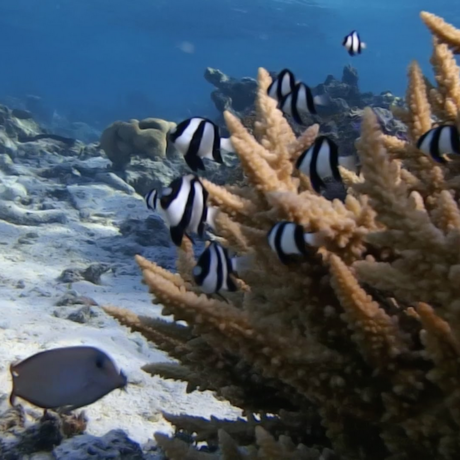Mandarin Dragonet

This animal is not currently on exhibit at the aquarium.
It’s not just the mandarin dragonet's magnificently vibrant coloring that's remarkable: its unusually large, outward-set eyes give it a distinctly amphibian head-on allure, while its style of swimming (a rapid pulse of the fins that’s more hovering than forward movement) calls to mind a tiny underwater hummingbird. Even the mandarin dragonet’s scientific name—Synchiropus splendidus—acknowledges how spectacular they are.
Mandarin dragonets are fairly solitary creatures, preferring to lie low in reefs and lagoons while bottom-feeding on small crustaceans and other invertebrates. Instead of scales, they're covered in a thick coating of slime, which makes it both resistant to parasitic marine diseases and much less attractive to hungry predators—a handy way to be left alone, though it’s not enough to deter humans looking for either a seafood delicacy or a stunning pet.
Indeed, humans are the mandarin dragonet's primary threat. In private aquariums, the mandarin’s peaceful disposition and food-fussiness are more curse than blessing—it’s poorly equipped to compete with any tankmates for food, especially from a supply that’s less diverse and plentiful than in its natural habitat. Consequently, the average life expectancy of the mandarin dragonet declines from 10-15 years in the wild to 2-4 years in captivity.
Range and Conservation Status
Mandarin dragonets live in the western Pacific Ocean, from Hong Kong down to Australia. (Laos and the Federated States of Micronesia have both paid them tribute on postage stamps.) The species has not been given a conservation status by the IUCN, but it's known to be threatened by overfishing and pollution, and in particular by its popularity in the private aquarium trade.
Mating
Shy as mandarin dragonets may be, they put on quite a show at mating time: each evening, females gather in small groups as males attempt to woo them; when a female chooses a beau, the couple conjoins and rises slowly above the coral reef, releasing a cloud of eggs and sperm into the ocean. Eggs that get fertilized are at the mercy of the current until they hatch and settle on the reef—no parenting duties in this species.
What’s In a Name?
The mandarin dragonet is also called the mandarinfish—both names share a nod to mandarins, bureaucrats of Imperial China who also wore brightly colored robes—but is not to be confused with the mandarin fish, or Chinese perch, which belongs to a different family altogether. But that's not all; the mandarin dragonet also answers to green dragonet, striped mandarinfish, psychedelic mandarinfish, and even mandarin goby—never mind that the goby is a different suborder of fish entirely.
Be mesmerized by colorful coral reef fish, soaring stingrays, and adorable African penguins—streaming live to your device, 24/7.






